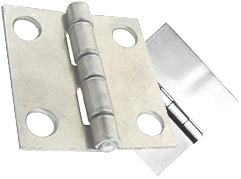
Hinges aren’t used exclusively indoors. You can find them outdoors as well. They are commonly found on gates, storage sheds, exterior doors, access panels, fences, enclosures and more. Most hinges feature two leafs that interlock together while forming a knuckle in the center. When installed, they allowed for a limited angle of rotation.
Not all hinges are suitable for outdoor use, however. Some of them are designed for indoor use. Using them outdoors may result in damage or degradation to either the hinge itself or the objects on which they are installed. So, what makes a hinge suitable for outdoor use exactly?
Corrosion-Resistant Material
If you’re planning to use a hinge outdoors, you should check to make sure it’s made of a corrosion-resistant material. When exposed to moisture, certain materials can corrode. Fortunately, hinges are available in a variety of corrosion-resistant materials, allowing them to withstand harsh outdoor environments.
Some of the most common corrosion-resistant materials in which hinges are made include the following:
- Stainless steel: an iron alloy with a minimum of 10% chromium, stainless steel offers a high level of protection against corrosion. The chromium acts as a barrier that shields the underlying iron from oxidation and corrosion.
- Brass: an alloy consisting of copper and zinc, brass features an attractive rustic appearance. More importantly, it’s protected from corrosion. You can use brass hinges outdoors without fear of them quickly corroding.
- Aluminum: another popular material for outdoor hinges is aluminum. It’s lightweight, and like stainless steel and brass, aluminum offers a high level of protection from corrosion.
Protective Finish
Hinges suitable for outdoor use often feature a protective finish. Some of them feature a zinc finish. During production, a thin layer of zinc is applied over the surface of the hinge. This zinc forms a protective barrier that allows the hinge to withstand moisture.
Some hinges even feature a UV-resistant finish. UV light can cause fading and degradation. It may not happen overnight, but months or years of exposure to sunlight can result in fading or degradation. UV-resistant finishes, though, are designed to protect against damage such as this.
Appearance
Outdoor hinges don’t just have to work — they need to look good as well. Decorative finishes such as matte black, bronze or polished stainless steel can complement the design of gates or other objects with which hinges are used. Just remember to choose a hinge made of a corrosion-resistant material if you are planning to use it outdoors.
